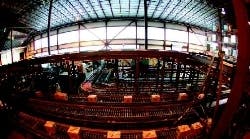Washington State Liquor Control Board's (WSLCB) new 163,200-sq.-ft., $30 million facility in downtown Seattle features an automated order sortation and fulfillment system that handles 3,000 active SKUs and 12,000 to 30,000 cases per day.
The need to automate came from four drivers: order fulfillment rate, order accuracy, inventory accuracy and ergonomic concerns.
"We wanted to offer a better level of service to our 360 stores," says Gene Kremer, general manager of WSLCB. The existing system did not maintain accurate inventory information or provide timely information on product movement.
System design
Designed, built, installed and integrated by order fulfillment specialists at FKI Logistex (St. Louis), the new system is designed for constant replenishment of all buffer storage areas, while fast-moving, slow-moving, full case and split-case product from each area is being shipped.
Each day, WSLCB processes orders for 70-75 stores and replenishes the system for the next day's shipments. It ships once a week to each store. Orders are received from the enterprise business system (EBS) each day for the following day's shipments. The warehouse management system (WMS) takes order information from the EBS to manage material and information flow.
Pallets are received in a staging area where quality checks are performed at one of seven docks, then they are transferred to a very narrow aisle (VNA) rack system. The 15-aisle VNA uses man-up turret trucks to service 9,074 storage locations.
The automated system uses buffer storage to inventory product on day one that will be required to fill orders shipped on day two. Buffer systems include:
- 28 double stacks of carousels using 14 inserter/extractor robots;
- 33 conveyor storage lanes for fast moving products;
- Full-case flow rack;
- Split-case flow rack;
- Manual carousels for slow-moving items.
Product flow
As order information is received, the WMS identifies what pallet loads are required to fulfill order requirements for the next day. Turret truck drivers use radio frequency (RF) terminals to pick pallets and move them to a staging area. Lift truck operators pick up those loads and deliver them to either a depalletizing station for manual carousels, or one of five manually assisted depalletizing stations.
A WMS terminal instructs operators how many cases need to be removed from each pallet. Operators apply a pre-printed bar code label on each case and push it from the pallet onto the conveying system. Partial pallets are conveyed to a pickup station, then moved back to the VNA staging area to be returned to storage.
Sorting product
Depalletized cases are conveyed to a sorter and routed to one of four buffer storage systems. Twenty-two high volume stock keeping units (SKUs making up 18% to 20% of daily volume) are routed to 33 accumulation lanes for storage. Other SKUs are routed to the automated carousel system, fullcase flow rack or split-case flow racks as required.
Loads of slow moving items (five to six cases per week) are sent to the manual carousel depalletizing station. At that station, the operator is directed via an RF terminal to remove the number of cases required for one week's inventory. These cases receive a bar code label, then are manually placed on a conveyor feeding the carousels. An operator scans the bar code label as cases arrive at the manual carousel. Software directs the operator, via a putto-light system, where to store the case.
Cases required for SKUs in the fullcase flow rack will be picked on day one and conveyed to automated carousels to fulfill day-two orders. Full cases are depalletized at a mezzanine level station and conveyed to the flow rack. Labels are scanned and product manually replenished to the reverse side of the full-case flow racks.
Product in manual carousels is also picked on day one for day-two's orders. Pick-to-light is used to direct operators to the required cases, which are manually loaded to carts and staged for nextday shipping.
On day two, trucks arrive at one of four shipping docks. The WMS is notified and sends order information to the automated material handling system. Cases are conveyed to a scanner and sorter, which routes them to the appropriate truck, where they are scanned again to verify accuracy. About 95% of the cases required for an order are conveyed to the truck with no operator intervention.
After the automated carousel requirements are met, cases are picked from accumulation lanes. These cases merge with product from automated carousels and travel to the shipping doors.
The final pieces of each order are manually loaded on extendable conveyors at the shipping docks.
Productivity at WSLCB has increased about 50%, and order fulfillment capacity has increased by 15%, or 17,000 cases per eight-hour shift, with a reduction in product breakage and loss.
The automated order sortation system handles 3,000 active SKUs and processes as many as 30,000 cases per day at peak season demand.
Cases merge with conveyed product from the carousels for travel to the shipping doors. Highvolume cases from accumulation lanes are managed to maintain SKU integrity so cases of the same SKU arrive at the truck as a group.



